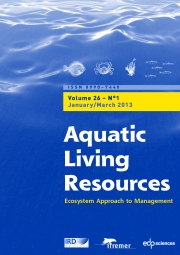Crossref Citations
This article has been cited by the following publications. This list is generated based on data provided by
Crossref.
Corbineau, A.
Rouyer, T.
Fromentin, J.-M.
Cazelles, B.
Fonteneau, A.
and
Ménard, F.
2010.
Patterns of variations in large pelagic fish: A comparative approach between the Indian and the Atlantic Oceans.
Progress in Oceanography,
Vol. 86,
Issue. 1-2,
p.
276.
Polanco, J.
Ganzedo, U.
Sáenz, J.
Caballero-Alfonso, A.M.
and
Castro-Hernández, J.J.
2011.
Wavelet analysis of correlation among Canary Islands octopus captures per unit effort, sea-surface temperatures and the North Atlantic Oscillation.
Fisheries Research,
Vol. 107,
Issue. 1-3,
p.
177.
Batchelder, Harold P.
Mackas, David L.
and
O’Brien, Todd D.
2012.
Spatial–temporal scales of synchrony in marine zooplankton biomass and abundance patterns: A world-wide comparison.
Progress in Oceanography,
Vol. 97-100,
Issue. ,
p.
15.
Lan, Kuo-Wei
Lee, Ming-An
Nishida, Tom
Lu, Hsueh-Jung
Weng, Jinn-Shing
and
Chang, Yi
2012.
Environmental effects on yellowfin tuna catch by the Taiwan longline fishery in the Arabian Sea.
International Journal of Remote Sensing,
Vol. 33,
Issue. 23,
p.
7491.
Lamb, Robert J.
MacKay, Patricia A.
and
Alyokhin, Andrei
2013.
Seasonal dynamics of three coexisting aphid species: implications for estimating population variability.
The Canadian Entomologist,
Vol. 145,
Issue. 3,
p.
283.
Heath, Joel P.
Borowski, Peter
and
Zhang, Shu-Dong
2013.
Quantifying Proportional Variability.
PLoS ONE,
Vol. 8,
Issue. 12,
p.
e84074.
Lan, Kuo-Wei
Evans, Karen
and
Lee, Ming-An
2013.
Effects of climate variability on the distribution and fishing conditions of yellowfin tuna (Thunnus albacares) in the western Indian Ocean.
Climatic Change,
Vol. 119,
Issue. 1,
p.
63.
Reygondeau, Gabriel
Longhurst, Alan
Martinez, Elodie
Beaugrand, Gregory
Antoine, David
and
Maury, Olivier
2013.
Dynamic biogeochemical provinces in the global ocean.
Global Biogeochemical Cycles,
Vol. 27,
Issue. 4,
p.
1046.
Galloway, Terry D.
and
Lamb, Robert J.
2014.
Abundance and stability are species traits for four chewing lice (Phthiraptera: Menoponidae, Philopteridae) on feral pigeons,Columba livia(Aves: Columbiformes: Columbidae).
The Canadian Entomologist,
Vol. 146,
Issue. 4,
p.
444.
Michael, Pamela E.
Tuck, Geoffrey N.
Strutton, Peter
and
Hobday, Alistair
2015.
Environmental associations with broad‐scale Japanese and Taiwanese pelagic longline effort in the southern Indian and Atlantic Oceans.
Fisheries Oceanography,
Vol. 24,
Issue. 5,
p.
478.
Nikolic, Natacha
Morandeau, Gilles
Hoarau, Ludovic
West, Wendy
Arrizabalaga, Haritz
Hoyle, Simon
Nicol, Simon J.
Bourjea, Jérôme
Puech, Alexis
Farley, Jessica H.
Williams, Ashley J.
and
Fonteneau, Alain
2017.
Review of albacore tuna, Thunnus alalunga, biology, fisheries and management.
Reviews in Fish Biology and Fisheries,
Vol. 27,
Issue. 4,
p.
775.
Lan, Kuo-Wei
Chang, Yi-Jay
and
Wu, Yan-Lun
2020.
Influence of oceanographic and climatic variability on the catch rate of yellowfin tuna (Thunnus albacares) cohorts in the Indian Ocean.
Deep Sea Research Part II: Topical Studies in Oceanography,
Vol. 175,
Issue. ,
p.
104681.
Wu, Yan-Lun
Lan, Kuo-Wei
and
Tian, YongJun
2020.
Determining the effect of multiscale climate indices on the global yellowfin tuna (Thunnus albacares) population using a time series analysis.
Deep Sea Research Part II: Topical Studies in Oceanography,
Vol. 175,
Issue. ,
p.
104808.
Curnick, David J.
Collen, Ben
Koldewey, Heather J.
Jones, Kate E.
Kemp, Kirsty M.
and
Ferretti, Francesco
2020.
Interactions Between a Large Marine Protected Area, Pelagic Tuna and Associated Fisheries.
Frontiers in Marine Science,
Vol. 7,
Issue. ,
Ong, Joyce J. L.
Walter, Jonathan A.
Jensen, Olaf P.
and
Pinsky, Malin L.
2021.
Global hotspots of coherent marine fishery catches.
Ecological Applications,
Vol. 31,
Issue. 5,
Nurholis
Sukoraharjo, S S
Lumban-Gaol, J
and
Syah, A F
2021.
Yellowfin Tuna Fishing Dynamic During Low IOD Positive and Negative at Eastern Indian Ocean; Study Case at Western Waters of Sumatera.
IOP Conference Series: Earth and Environmental Science,
Vol. 695,
Issue. 1,
p.
012010.
Lan, Kuo-Wei
Wu, Yan-Lun
Chen, Lu-Chi
Naimullah, Muhamad
and
Lin, Tzu-Hsiang
2021.
Effects of Climate Change in Marine Ecosystems Based on the Spatiotemporal Age Structure of Top Predators: A Case Study of Bigeye Tuna in the Pacific Ocean.
Frontiers in Marine Science,
Vol. 8,
Issue. ,
Wang, Yang
Zhang, Fan
Geng, Zhe
Zhang, Yuying
Zhu, Jiangfeng
and
Dai, Xiaojie
2023.
Effects of Climate Variability on Two Commercial Tuna Species Abundance in the Indian Ocean.
Fishes,
Vol. 8,
Issue. 2,
p.
99.
Pham, Anh H.
Choisnard, Noémie
Fernández-Carrera, Ana
Subramaniam, Ajit
Strope, Erica K.
Carpenter, Edward J.
Voss, Maren
and
Montoya, Joseph P.
2024.
Planktonic habitats in the Amazon Plume region of the Western Tropical North Atlantic.
Frontiers in Marine Science,
Vol. 11,
Issue. ,
YAKUSHOV, Vasily D.
and
SHEFTEL, Boris I.
2024.
Are population cycles recovering?.
Integrative Zoology,
Vol. 19,
Issue. 3,
p.
538.




